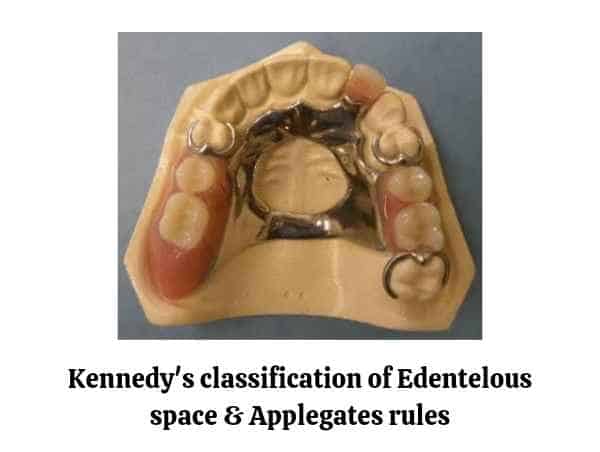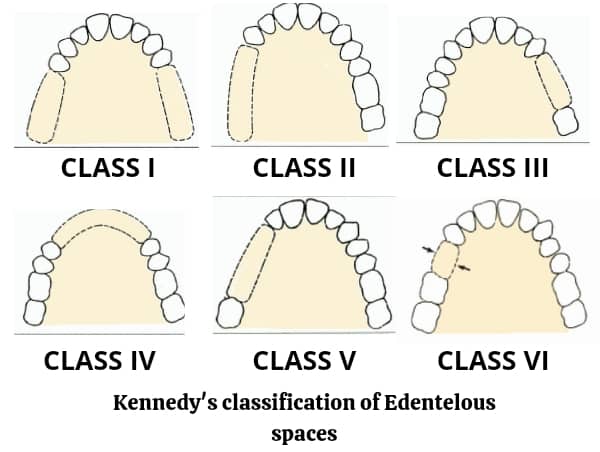Dr Edward Kennedy proposed this classification of Edentulous spaces in 1923. It is the most widely used classification of Edentulous arches. The classification is useful for the treatment of partially Edentulous arches.

Kennedy’s classification of Partially Edentulous arches (1923)
Kennedy had classified the Edentulous spaces into four classes, but later, two more classes were added as Applegate’s modification. Let’s learn about all of them.

Here is a table explaining all the classes of Kennedy’s classification:
| Kennedy Classification | Description |
|---|---|
| Class I | Bilateral edentulous areas located posterior to the remaining natural teeth. |
| Class II | Unilateral edentulous areas located posterior to the remaining natural teeth. |
| Class III | Unilateral edentulous areas with natural teeth remaining both anterior and posterior to the edentulous areas. |
| Class IV | Edentulous area located anterior to the remaining natural teeth. |
| Class V | Edentulous area where anterior tooth is not suitable for abutment. |
| Class VI | Edentulous area where both anterior and posterior teeth are suitable for abutments. |
Class I – Bilateral Edentulous areas located posterior to the remaining natural teeth. i.e. Two Edentulous spaces are seen in the posterior region with no teeth posterior to it.
Class II – Unilateral Edentulous area located posterior to the remaining natural teeth. i.e. There is only one Edentulous space in the posterior region with no teeth posterior to it.
Class III – Unilateral Edentulous area with natural teeth both anterior and posterior. i.e. It has an edentulous space surrounded by natural teeth on both sides, which do not cross the midline.
Class IV – Single bilateral edentulous area located anterior to the remaining natural teeth. There is a single edentulous space crossing the midline of the arch with natural teeth posterior to it on both sides.
Applegate’s modifications (1960)
Class V – Kennedy Class III, but the anterior abutment (Lateral incisor) is unsuitable for support.
Class VI – Kennedy Class III, in which the anterior abutment is suitable for support. This class hardly requires tissue support, while all other RPD (Removable partial dentures) require tissue support. Thus, it differs from the Kennedy Class III classification and is seen as a separate class.
Applegate’s rules
These rules are considered for determining Kennedy’s classification. It holds equal importance to that Kennedy’s classification.
Rule 1 – Classification should follow rather than precede extractions that might alter the original classification.
Rule 2 – If the third molar is missing and not to be replaced, it is not considered in the classification.
Rule 3 – If the third molar is present and is to be used as an abutment, it is considered in the classification.
Rule 4 – If the second molar is missing and is not to be replaced, it is not considered in the classification.
Rule 5 – The most posterior edentulous area or areas always determine the classification.
Rule 6 – Edentulous areas other than those that determine the classification are referred to as modification spaces. These spaces are designated by their number.
Rule 7 – The extent of the modification is not considered; only the number of additional edentulous areas, i.e. the number of teeth missing in the modification spaces, is not considered only the number of additional edentulous spaces are considered.
Rule 8 – There can be no modification areas in class IV because any additional edentulous space will definitely be posterior to it and will determine the classification.